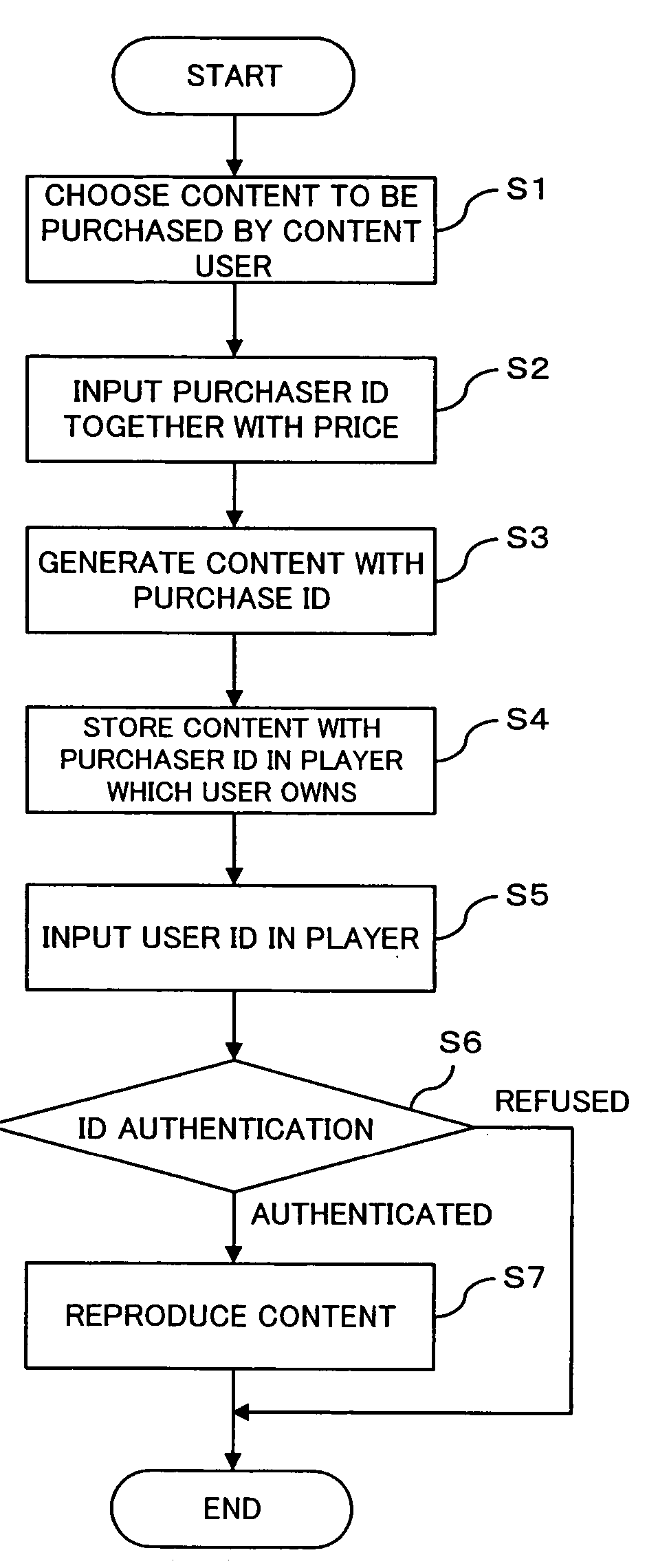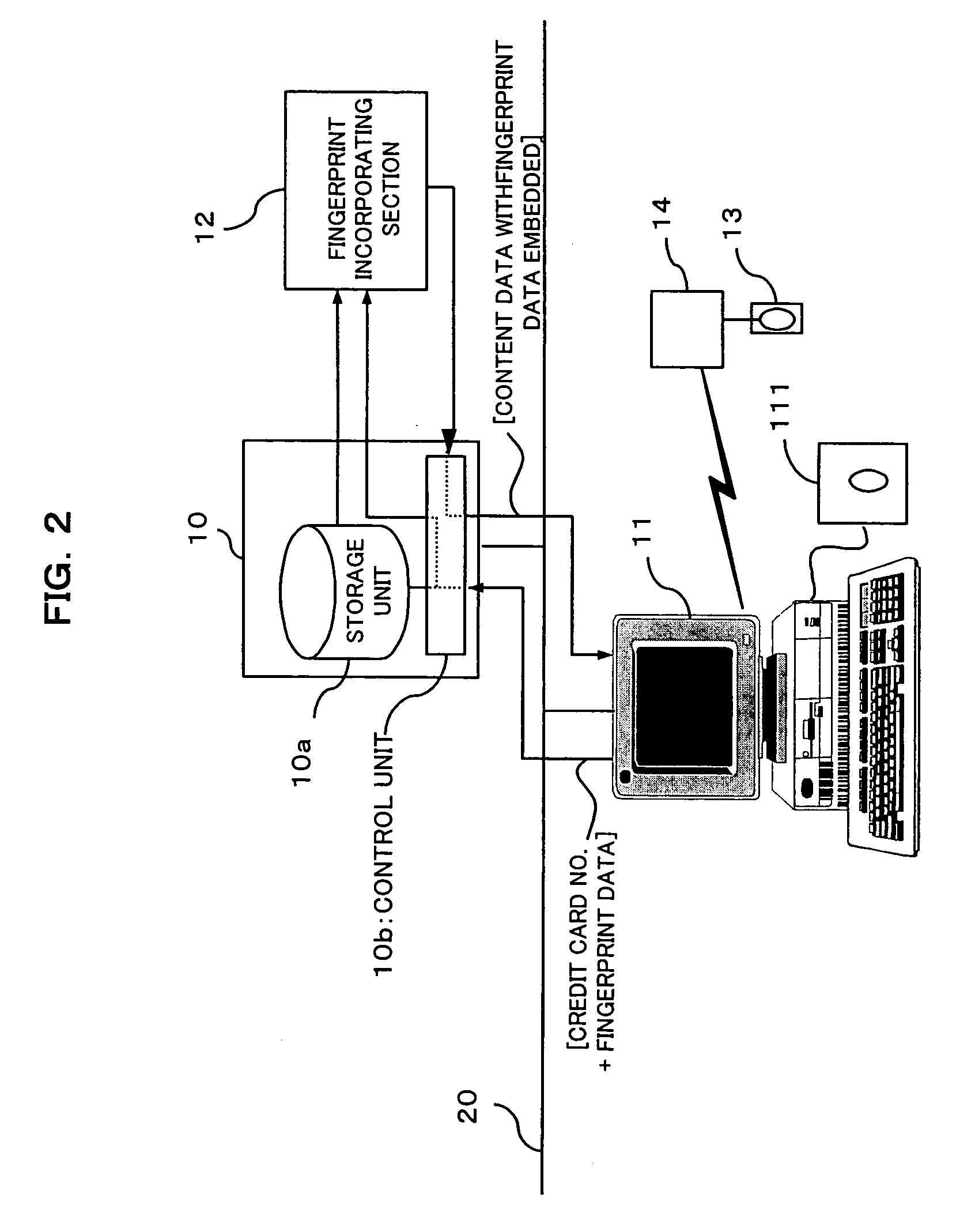Content providing system and content reproducing apparatus
a content providing system and content technology, applied in the direction of digital transmission, program/content distribution protection, instruments, etc., can solve the problems of illegally copied content data flooding the internet, data cannot be reproduced, and users are not allowed to provide copied data to unspecified third parties, so as to prevent any ill will
- Summary
- Abstract
- Description
- Claims
- Application Information
AI Technical Summary
Benefits of technology
Problems solved by technology
Method used
Image
Examples
example 1
[0079]FIG. 1 is a flow chart (Steps S1 through S7) for describing a flow of basic processing (Example 1) in a content providing system according to the present invention. In the embodiment, to a content reproducing apparatus (for example, a music player, VTR, DVD player, or the like) which the content user possesses, a section to input the user identification information (hereinafter, referred to as the “user ID”) that can identify the owner (content user) individual of the apparatus should be equipped.
[0080] In the event that a content purchaser purchases content to be reproduced at the content reproducing apparatus, as shown in FIG. 1, the content purchaser chooses content to be purchased (Step S1), pays the counter value for the use of the content to a content manager (for example, a music distribution company or the like) and at the same time notifies the purchaser identification information (purchaser ID) that can identify the purchaser individual (Step S2). On the content man...
example 2
[0104] In the above-mentioned player 14, the user must enter fingerprint data from the fingerprint sensor 13 every time the content is reproduced. However, the fingerprint is not entered in the player 14 at the time of content reproduction but fingerprint data as the user ID may be stored in the player 14 in advance. In such event, a memory (see reference numeral 144 in FIG. 14) to store the user ID (biometric information) is equipped in the layer 14 and by comparing the user ID in this memory with the purchaser ID in content, the user is authenticated. By this, it is possible to eliminate the trouble to enter the user ID every time the content is used and at the same time, it is no longer necessary to equip a special function (for example, fingerprint sensor) to enter the user ID into the player 14.
[0105] As described above, the flow of basic processing in the content providing system configured to register the user ID (fingerprint data) to the player 14 in advance (example 2) wil...
example 3
[0140] As described in item [1-10], even if the user has possessed content by the data exchange software (file sharing software), the user can use the content only within the trial use range unless the purchaser ID incorporated in the content is of the user him / herself. Consequently, the above-mentioned user must access the content management server 10 anew and purchase the content in order to officially utilize the content even if the user possesses the content.
[0141] Therefore, the user may be allowed to officially use the content not by purchasing the content newly but by rewriting the purchaser ID (biometric information) in the content which the user already possesses to the biometric information of the user.
[0142] In such event, the content manager (content right owner, original copyright owner) has a purchaser identification information changing section (see ID changing server 16 of FIG. 15 and FIG. 16) that changes the purchaser ID (biometric information) already incorporat...
PUM
 Login to View More
Login to View More Abstract
Description
Claims
Application Information
 Login to View More
Login to View More - R&D
- Intellectual Property
- Life Sciences
- Materials
- Tech Scout
- Unparalleled Data Quality
- Higher Quality Content
- 60% Fewer Hallucinations
Browse by: Latest US Patents, China's latest patents, Technical Efficacy Thesaurus, Application Domain, Technology Topic, Popular Technical Reports.
© 2025 PatSnap. All rights reserved.Legal|Privacy policy|Modern Slavery Act Transparency Statement|Sitemap|About US| Contact US: help@patsnap.com



